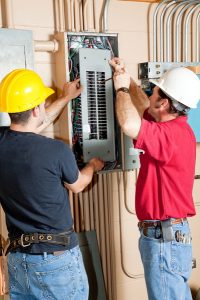 Homeowners throughout the U.S. have become more and more dependent on electronic devices and high efficiency appliances. Combined with inclement weather of any kind—such as thunderstorms—the risk of power surges increase. They pose a serious threat, more serious than you may realize, to your electronic equipment and appliances.
Homeowners throughout the U.S. have become more and more dependent on electronic devices and high efficiency appliances. Combined with inclement weather of any kind—such as thunderstorms—the risk of power surges increase. They pose a serious threat, more serious than you may realize, to your electronic equipment and appliances.
Perhaps you believe you can get by with the small, portable surge protectors you can buy at any hardware or office supply store. These are referred to as power strips, and they are very convenient, allowing you to bypass any problems with limited outlets and plug in everything from your TV and stereo to your computer and all computer accessories. Unfortunately, though, power strips do not offer your appliances the comprehensive protection they need. For safeguarding of this caliber, we recommend you consider the installation of a whole-house surge protection system.
Which Appliances in My Home Need Surge Protection?
Anything with a circuit board! This means your HVAC system, your clothes washer and dryer, any entertainment equipment and appliances you have, and even your LED lighting. There’s increasing technology that we’re all plugging into our homes, and it needs protection.
Another thing to consider is even if you do have the above-mentioned power strips, it’s nearly impossible to get every single electrical component you have plugged into them, which is why we said above that they don’t provide comprehensive protection. It’s estimated that the average household can have as much as $10,000 worth of unprotected electrical equipment, without the right surge protection in place.
You May Unknowingly be Experiencing Power Surges
Most homeowners associate power surges with lightning. Yes, the biggest and most noticeable power surges can occur along with lightning and thunderstorms. But it’s rare that one large surge will impact your appliances all at once.
What’s more concerning is the accumulation of mini-surges from things like your HVAC system. It introduces small surges into your home’s electrical lines over time, until it eventually causes other appliances to suffer and even fail along with it.
With whole-house surge protection at your circuit breaker, though, you can make sure that your entire electrical system is protecting. Without whole-house surge protection, when your HVAC system or generator sends a surge back to your electrical panel, it can result in damage to the whole panel, and therefore the systems attached to it.
What Type of Surge Protector Do You Need?
In most cases, to adequately protect your home and electrical systems, your surge protector can be installed directly into the electrical panel, where it will stem the flow of electricity when the power does surge.
If you need a larger, more powerful surge protection system, however, then the system can be installed outside of your electrical panel if needed.
No matter what type of surge protection you choose, it must be professionally installed by trained technicians. This will keep your appliances and electrical equipment safe.
